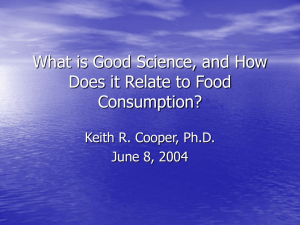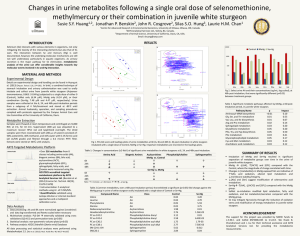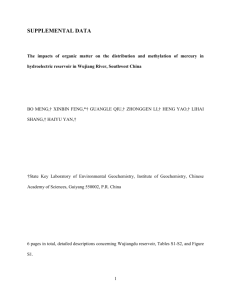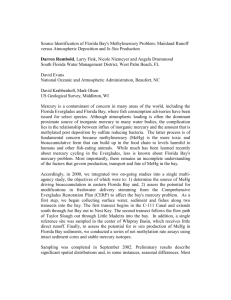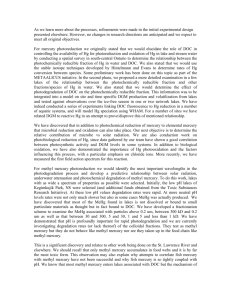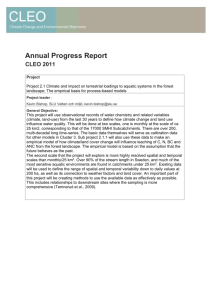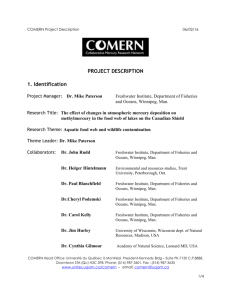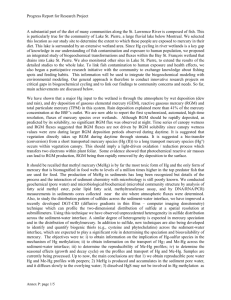Research Spatial Characteristics of Net
advertisement
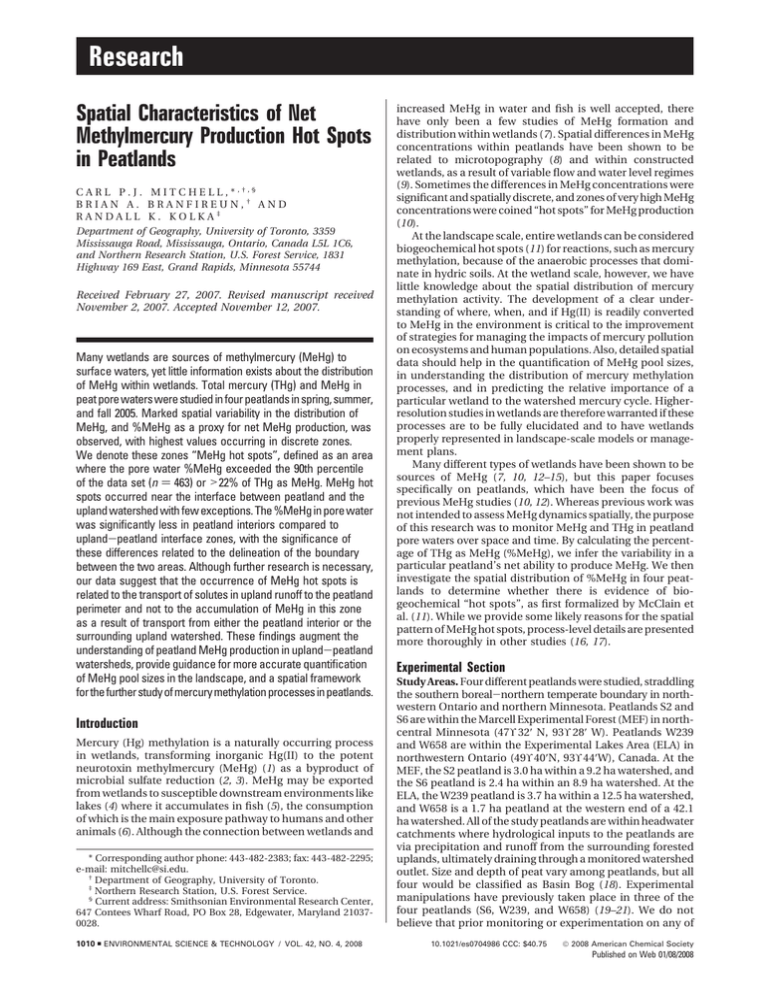
Research Spatial Characteristics of Net Methylmercury Production Hot Spots in Peatlands C A R L P . J . M I T C H E L L , * ,†,§ BRIAN A. BRANFIREUN,† AND RANDALL K. KOLKA‡ Department of Geography, University of Toronto, 3359 Mississauga Road, Mississauga, Ontario, Canada L5L 1C6, and Northern Research Station, U.S. Forest Service, 1831 Highway 169 East, Grand Rapids, Minnesota 55744 Received February 27, 2007. Revised manuscript received November 2, 2007. Accepted November 12, 2007. Many wetlands are sources of methylmercury (MeHg) to surface waters, yet little information exists about the distribution of MeHg within wetlands. Total mercury (THg) and MeHg in peat pore waters were studied in four peatlands in spring, summer, and fall 2005. Marked spatial variability in the distribution of MeHg, and %MeHg as a proxy for net MeHg production, was observed, with highest values occurring in discrete zones. We denote these zones “MeHg hot spots”, defined as an area where the pore water %MeHg exceeded the 90th percentile of the data set (n ) 463) or >22% of THg as MeHg. MeHg hot spots occurred near the interface between peatland and the upland watershed with few exceptions. The %MeHg in pore water was significantly less in peatland interiors compared to upland-peatland interface zones, with the significance of these differences related to the delineation of the boundary between the two areas. Although further research is necessary, our data suggest that the occurrence of MeHg hot spots is related to the transport of solutes in upland runoff to the peatland perimeter and not to the accumulation of MeHg in this zone as a result of transport from either the peatland interior or the surrounding upland watershed. These findings augment the understanding of peatland MeHg production in upland-peatland watersheds, provide guidance for more accurate quantification of MeHg pool sizes in the landscape, and a spatial framework forthefurtherstudyofmercurymethylationprocessesinpeatlands. Introduction Mercury (Hg) methylation is a naturally occurring process in wetlands, transforming inorganic Hg(II) to the potent neurotoxin methylmercury (MeHg) (1) as a byproduct of microbial sulfate reduction (2, 3). MeHg may be exported from wetlands to susceptible downstream environments like lakes (4) where it accumulates in fish (5), the consumption of which is the main exposure pathway to humans and other animals (6). Although the connection between wetlands and * Corresponding author phone: 443-482-2383; fax: 443-482-2295; e-mail: mitchellc@si.edu. † Department of Geography, University of Toronto. ‡ Northern Research Station, U.S. Forest Service. § Current address: Smithsonian Environmental Research Center, 647 Contees Wharf Road, PO Box 28, Edgewater, Maryland 210370028. 1010 9 ENVIRONMENTAL SCIENCE & TECHNOLOGY / VOL. 42, NO. 4, 2008 increased MeHg in water and fish is well accepted, there have only been a few studies of MeHg formation and distribution within wetlands (7). Spatial differences in MeHg concentrations within peatlands have been shown to be related to microtopography (8) and within constructed wetlands, as a result of variable flow and water level regimes (9). Sometimes the differences in MeHg concentrations were significant and spatially discrete, and zones of very high MeHg concentrations were coined “hot spots” for MeHg production (10). At the landscape scale, entire wetlands can be considered biogeochemical hot spots (11) for reactions, such as mercury methylation, because of the anaerobic processes that dominate in hydric soils. At the wetland scale, however, we have little knowledge about the spatial distribution of mercury methylation activity. The development of a clear understanding of where, when, and if Hg(II) is readily converted to MeHg in the environment is critical to the improvement of strategies for managing the impacts of mercury pollution on ecosystems and human populations. Also, detailed spatial data should help in the quantification of MeHg pool sizes, in understanding the distribution of mercury methylation processes, and in predicting the relative importance of a particular wetland to the watershed mercury cycle. Higherresolution studies in wetlands are therefore warranted if these processes are to be fully elucidated and to have wetlands properly represented in landscape-scale models or management plans. Many different types of wetlands have been shown to be sources of MeHg (7, 10, 12–15), but this paper focuses specifically on peatlands, which have been the focus of previous MeHg studies (10, 12). Whereas previous work was not intended to assess MeHg dynamics spatially, the purpose of this research was to monitor MeHg and THg in peatland pore waters over space and time. By calculating the percentage of THg as MeHg (%MeHg), we infer the variability in a particular peatland’s net ability to produce MeHg. We then investigate the spatial distribution of %MeHg in four peatlands to determine whether there is evidence of biogeochemical “hot spots”, as first formalized by McClain et al. (11). While we provide some likely reasons for the spatial pattern of MeHg hot spots, process-level details are presented more thoroughly in other studies (16, 17). Experimental Section Study Areas. Four different peatlands were studied, straddling the southern boreal-northern temperate boundary in northwestern Ontario and northern Minnesota. Peatlands S2 and S6 are within the Marcell Experimental Forest (MEF) in northcentral Minnesota (47° 32′ N, 93° 28′ W). Peatlands W239 and W658 are within the Experimental Lakes Area (ELA) in northwestern Ontario (49° 40′N, 93° 44′W), Canada. At the MEF, the S2 peatland is 3.0 ha within a 9.2 ha watershed, and the S6 peatland is 2.4 ha within an 8.9 ha watershed. At the ELA, the W239 peatland is 3.7 ha within a 12.5 ha watershed, and W658 is a 1.7 ha peatland at the western end of a 42.1 ha watershed. All of the study peatlands are within headwater catchments where hydrological inputs to the peatlands are via precipitation and runoff from the surrounding forested uplands, ultimately draining through a monitored watershed outlet. Size and depth of peat vary among peatlands, but all four would be classified as Basin Bog (18). Experimental manipulations have previously taken place in three of the four peatlands (S6, W239, and W658) (19–21). We do not believe that prior monitoring or experimentation on any of 10.1021/es0704986 CCC: $40.75 2008 American Chemical Society Published on Web 01/08/2008 these study sites has had an impact on data presented here; however any possible influences are considered in the interpretation of results. All four of the study peatlands have a distinct outer region where relatively nutrient-rich upland runoff and nutrientpoor peatland waters mix, referred to as either the peatland lagg or the upland-peatland interface zone. In two of the study peatlands, S2 and S6, the boundary between the lagg and the interior peatland is visually distinguished by abrupt changes in vegetation. The lagg width is variable in S2, ranging from approximately 1–10 m. In S6, the lagg is a more dominant feature, encompassing approximately 40% of the peatland area. In the other two peatlands, W239 and W658, a lagg is apparent, but the boundary is less distinguishable because of more subtle vegetation gradients. Climate at the MEF is characterized as subhumid continental. Mean January and July air temperatures were -16 and 20 °C, respectively, during the 2005 study year and total precipitation for 2005 was 672 mm, which are typical values for this region (22). Climate at the ELA is characterized as cold temperate continental. Mean January and July air temperatures were -18 and 20 °C, respectively, during the 2005 study year and total precipitation for 2005 was 762 mm, which are typical values for the ELA (23). Field Sampling. Ultraclean trace metal protocols were used at all times for the preparation of sampling equipment and for the sampling of water in the field (24). To determine seasonal variability, pore waters were sampled at all four peatlands in the spring (early June), summer (early August), and fall (early October) of 2005. At certain times, some locations could not be sampled because of dry conditions (e.g., spring and summer sampling in S2 and fall sampling in W658). Upland runoff was sampled on an event basis from previously installed upland surface runoff and interflow collectors in the watersheds of S2 and S6 only (see ref 22 for details). Having no a priori knowledge of the spatial patterns but hypothesizing that upland runoff into the peatland margin may be important to MeHg production, we established several transects spanning the entire width of each peatland. Previous research has also looked for discrete zones of biogeochemical activity using transects in riparian zones (25, 26). Pore water samples were obtained over an integrated depth of 2.5-7.5 cm below the water table using a Teflon piezometer and a peristaltic pump. This sampling strategy was used (1) so that the sampled depth relative to the water table was constant throughout the study, (2) because other studies have shown that the zone immediately below the water table is most important for mercury methylation (12), and (3) because this generated fewer samples than a detailed profile, permitting a more spatially extensive sampling strategy. In addition to transects, high-resolution sampling grids (12 points in an approximate 10 × 10 m square) were established in S2 and S6 at the upland-peatland interface and sampled in the same manner as above. All samples were filtered in the field using a peristaltic pump and acid-washed Teflon tubing with ashed 0.7 µm glass fiber filters in precleaned and acid-washed Teflon inline filter holders. Samples for THg and MeHg analysis were collected in PETG bottles, acidified to 0.5% immediately with concentrated ultrapure HCl, double bagged, and kept in dark plastic bags in a cold cooler until return from the field. Filtered samples were collected in HDPE bottles for analysis of pH, dissolved organic carbon (DOC), and major ions and kept in a cold cooler until return from the field. Water Analyses. THg and MeHg analyses were performed in a Class 100 cleanroom at the University of Toronto and analyzed by cold vapor atomic fluorescence spectrometry (CVAFS) using U.S. Environmental Protection Agency Methods 1631 and 1630, respectively (27, 28). Recovery of a MeHg FIGURE 1. Frequency distribution of %MeHg in all pore water samples and box-and-whisker plot of %MeHg (inset). In the box and whisker plot, the box represents the limit of the 1st and 3rd quartiles, the line within the box represents median, and the outside ticks represent range. Locations with values of %MeHg above the 90th percentile are considered to be MeHg hot spots. spike (mean ( standard deviation) was 99 ( 15% (n ) 91), replication of duplicates was 10 ( 7% (n ) 48 pairs), and the detection limit, calculated as 3σ of distillate blanks, was 0.06 ng/L (n ) 50). Recovery of a THg spike was 100 ( 5% (n ) 35), replication of duplicates was 2.0 ( 1.7% (n ) 75 pairs), and the detection limit was 0.23 ng/L (n ) 48). Major ions were analyzed by ion chromatography at the University of Toronto. pH was measured immediately on return from the field using an Orion pH triode meter. Dissolved organic carbon (DOC) was analyzed on a Shimadzu 5050 Total Organic Carbon Analyzer at McGill University. Spatial Mapping and Statistical Methods. All sampling points were flagged and georeferenced with a hand-held GPS unit. The delineation of sampling points into either the upland-peatland interface (UPI) or the peatland interior (INT) was determined by two methods. In the first, the UPI and INT of S2 and S6 were delineated visually using the abrupt vegetation change between lagg and peatland interior as the boundary. This was not done in peatlands W239 or W658 because the lagg boundaries are not as visually abrupt. The second method was applied to all four peatlands. An incrementally wider UPI (widths of 2.5, 5.0, 10, and 15 m) was applied in relation to the peatland boundary. Sampling points falling within or outside of each width category were included as UPI or INT samples, respectively. ESRI ArcGIS 9 was used to spatially map peatland-scale pore water chemistry. Grid-sampling points at the upland-peatland interface were georeferenced using a Sokkia Set 4B Electronic Total Station. Grid-sampling data were interpolated to better illustrate patterns of chemical concentrations; kriging algorithms in Surfer were used. The Shapiro-Wilks’ W test was conducted to test for normality on all %MeHg data. The %MeHg data were not normal (Figure 1; W ) 0.697; p < 0.001), so nonparametric statistical tests were conducted and considered significant at p e 0.05. INT and UPI samples were compared using the Mann–Whitney U Test. Correlations between chemical variables were examined using the Spearman R coefficient. Results and Discussion Defining a Methylmercury Hot Spot. McClain et al. (11) define biogeochemical hot spots as “areas (or patches) that show disproportionately high reaction rates relative to the surrounding area (or matrix).” In the context of mercury methylation, a hot spot could be characterized by (1) the direct measurement of potential mercury methylation rates VOL. 42, NO. 4, 2008 / ENVIRONMENTAL SCIENCE & TECHNOLOGY 9 1011 TABLE 1. Chemical Characteristics of Pore Water in the Peatland-Scale Studya peatland W239 (n ) 74) W658 (n ) 88) S2 (n ) 81) S6 (n ) 94) [MeHg] (ng/L) c 0.62 (dl –7.62) 0.43 (dlc–2.78) 0.37 (dlc–3.15) 0.35 (dlc–10.2) [THg] (ng/L) 5.5 (1.6–15.0) 8.4 (1.9–22.5) 13.3 (4.4–111.0) 7.9 (2.8–21.1) %MeHg 15.9 (0.3–59.9) 6.7 (0.5–32.4) 2.7 (0.3–22.3) 4.6 (0.2–61.5) [DOC] (mg/L) [SO42-] (mg/L) pHb hot spots 29.0 (3.8–55.8) 32.8 (16.1–67.4) 66.4 (2.4–139.6) 44.0 (3.3–98.0) 0.4 (<dl -15.3) 0.6 (0.04–15.5) 3.0 (0.03–46.4) 0.1 (<dlc-13.9) 4.8 (3.9–6.0) 5.0 (4.4–6.0) 4.0 (3.3–6.6) 4.5 (3.9–5.4) 19 8 1 13 c a Median values with range in parenthesis, where applicable. b Number of samples for pH analysis is less than the other parameters because of an electrode malfunction during the spring sampling: W239, n ) 48; W658, n ) 54; S2, n ) 56; S6, n ) 62. c dl ) detection limit. FIGURE 2. Contour plots of %MeHg in high-resolution sampling grids illustrating the seasonal variability in spatial pattern of %MeHg in pore water of the upland-peatland interface zones of peatlands S6 and S2. The dashed line in the upper right corner of each plot represents the upland-peatland interface, corresponding to a change in topography and a change from organic to mineral soils. Hillslope runoff is thus from the upper right toward the lower left of each plot. + represents pore water sampling points. (e.g., through the use of mercury stable isotopes; see ref 29) or (2) the use of an indirect measure of the ability of the environment to produce MeHg. The direct determination of methylation potentials was not conducive to the very large sample numbers and repeated measurements in this study. In this study, we measured the component of THg that was MeHg (%MeHg) in pore waters as an indication of how readily inorganic Hg was converted to MeHg and defined locations having disproportionately high %MeHg as hot spots. Previous research in the Florida Everglades, for example, has shown significant positive relationships between %MeHg and enriched stable isotope-derived measurements of mercury methylation rates (30). Still, because the net production of MeHg is the difference between Hg methylation and MeHg demethylation, an important caveat is that the MeHg hot spots presented here represent areas of elevated net MeHg production. The McClain et al. (11) definition of a biogeochemical hot spot does not specifically define what a “disproportionately” high reaction rate is. To determine what a disproportionately high %MeHg value would be in our study, we assessed the distribution of %MeHg in all of our samples (n ) 463). The distribution of data was positively skewed (Figure 1). 1012 9 ENVIRONMENTAL SCIENCE & TECHNOLOGY / VOL. 42, NO. 4, 2008 The median value for %MeHg was 5.3%, with a range between 0.2% and 62%. For the purposes of this study, we defined a MeHg hot spot as any place where the %MeHg in pore water exceeded the 90th percentile value for all samples used in this study (i.e., 22%). MeHg concentration and %MeHg had a significant positive correlation (Spearman R ) 0.820; p < 0.001; Supporting Information Figure S1 and Table S-T1). Thus, MeHg hot spots also tended to have high pore water concentrations of MeHg. This correlation may also imply that THg concentrations were relatively constant across our samples, but this was not the case (Table 1); however the variability in MeHg concentrations was an order of magnitude higher than for THg concentrations. Thus, we find that the supply of Hg is an important parameter for Hg methylation, and other factors such as the supply of labile organic carbon, pH, and sulfate reduction activity are also important in the determination of the amount of inorganic Hg converted to MeHg ((30); Table S-T1 of Supporting Information). Size of Methylmercury Hot Spots. Higher-resolution sampling at the UPI of peatlands S2 and S6 revealed that MeHg hot spots occurred as both discrete points and bands of varying length, and these patterns varied over time (Figure 2). In general, pore waters in the 5 m closest to the upland interface had considerably higher %MeHg than pore waters 5-10 m from the upland interface. However, the spatial extent of hot spots in relation to the upland interface may vary within different peatlands. Since point measurements of high pore water %MeHg appear to coalesce in some of the study plots, we suggest that while the maximum width of a hot spot is 3 m (the sampling resolution), the length of hot spots may vary in a direction parallel to the upland interface. The size of MeHg hot spots in this study is of a similar scale to riparian zone denitrification hot spots previously observed by Hedin et al. (25). Spatial Patterns of Methylmercury Hot Spots. It is apparent that these different peatlands have variable amounts and distributions of MeHg, THg, %MeHg, and other chemical variables (Table 1). MeHg concentrations and %MeHg vary widely in each peatland (>100 times). THg concentrations also vary spatially, but less so (∼10 times). MeHg hot spots are most often found at or near the UPI, whereas %MeHg values are considerably lower in the INT (Figure 3). This is similar to other biogeochemical hot spots reported in the literature, which occur predominantly at the interface between ecosystem compartments (11). There are a few exceptions to the spatial pattern, such as is evident at the lower end of peatland S6 (Figure 3). Although %MeHg values are high toward the interior of the peatland here, these values are highest at the UPI with a decreasing gradient toward the middle of the peatland. One other outlier in S6 during the summer sampling season (61.5% MeHg; Table S-T5 of Supporting Information) was located just outside of the UPI and was also an outlier for sulfate concentration (6.61 mg/L). Other than its relation to an area of inexplicably high sulfate concentration, the reasons for this outlier are unknown. FIGURE 3. Grayscale symbol maps showing the spatial and seasonal patterns of %MeHg in pore water of the four study peatlands. Peatland S2 had considerably lower %MeHg than the other peatlands. The water table in S2 was much lower than in the other studied peatlands (data not shown). During the summer sampling period, the water table in S2 fell to more than 70 cm below the surface, and pore water samples were difficult to obtain. The period of soil oxidation in S2 contributed to the higher concentrations of THg, sulfate, and DOC through aerobic degradation or oxidation processes (Table 1). Because of these conditions, the %MeHg values were low, and few statistical tests demonstrate differences between the UPI and INT in S2 (Table S-T4 of Supporting Information). Median values of %MeHg were considerably higher in the UPI than in the INT of peatlands W239, W658, and S6 (Tables S-T2, S-T3, and S-T5 of Supporting Information). Statistically significant differences in %MeHg between the UPI and INT were found in these peatlands but varied in relation to the UPI width used in our analysis. Differences in peatland W239 occurred more often when the UPI width VOL. 42, NO. 4, 2008 / ENVIRONMENTAL SCIENCE & TECHNOLOGY 9 1013 FIGURE 4. Scatterplots of the relationship between %MeHg and (a) DOC concentration, (b) sulfate concentration, and (c) pH. Sample points above the dashed line represent MeHg hot spots. was set to 15 m, whereas differences in peatlands W658 and S6 were most apparent when the UPI width was less than 10 m. The finding that both higher %MeHg and spatially discrete MeHg hot spots are focused in the UPI zone is of particular importance because other research has shown this to be the dominant source area for runoff from watersheds such as these (31, 32). Therefore, the high levels of net MeHg production in the UPI may contribute much of the MeHg leaving these watersheds. Despite the sampling effort being spatially extensive, some caveats regarding our sampling strategy and the statistical evaluation of this data should be expressed. First, the spacing between sampling points was at times greater than 10 m. It is thus possible that a MeHg hot spot may be missed simply because there was no a priori knowledge about the location or size of MeHg hot spots in peatlands. Second, our transect strategy has in some instances resulted in under-sampling of INT and oversampling of UPI zones. Further research of this type could adopt a random stratified sampling design to resolve this issue. Finally, in peatland S6, the %MeHg was 1014 9 ENVIRONMENTAL SCIENCE & TECHNOLOGY / VOL. 42, NO. 4, 2008 higher in the outlet half of the peatland (where prior additions of sulfate have taken place; see ref 19) in comparison to the upstream half of the peatland. It should be noted that all samples from S6 were taken 1 to 2 weeks prior to sulfate additions during the 2005 study year and that results from Jeremiason et al. (19) demonstrated only transient increases in MeHg concentration. The %MeHg values from peatland S6 do not appear as outliers in our data set (Table 1); thus the effect of experimental manipulations does not appear to compromise our findings. Some MeHg hot spots were temporally persistent throughout seasonal sampling; however, others were transient (Figure 3). Seasonal sampling was likely not of sufficient temporal resolution to determine the reasons for such variability. It should be noted that biogeochemical hot spots are not necessarily static and may vary over time, as do the hydrological flowpaths that lead to their occurrence (11). The temporal variability requires further study, specifically with respect to storm event-scale variability (i.e., ref 33). The purpose of this research was to characterize the spatial patterns of net MeHg production in peatlands. We have shown that areas closer to the surrounding uplands have higher pore water %MeHg, but the reasons for this trend are not entirely clear. More specific process-based research on this topic can be found in other recent research (16, 17) or is forthcoming, but we provide some likely reasons for the observed patterns here. Our hypothesis was that MeHg hot spots would be concentrated at the UPI because upland runoff can deliver limiting reactants such as sulfate to this zone (32). Samples collected from upland runoff collectors in the S6 watershed had higher median sulfate concentrations (3.8 mg/L; range: 0.68–42.2 mg/L; n ) 19), lower median DOC concentrations (10.8 mg/L; range: 6.8–85.8 mg/L; n ) 19), and higher median pH (6.3; range: 4.7–7.2; n ) 19) than that found in either the UPI or INT. Concentrations observed in the UPI data (Table S-T5 of Supporting Information) are between those from the uplands and that observed in the INT. This strongly supports previous research that this area is a zone for hydrological mixing of upland and peatland waters (31, 32). Our overall data also shows that higher %MeHg in pore water is related to the relatively higher pH, higher sulfate concentration, and lower DOC concentrations found in the UPI (Figure 4). Other research has shown a significant spatial gradient in sulfate concentration across the UPI, suggesting high levels of sulfate reduction (17, 33). Because the activity of sulfatereducing bacteria is directly related to MeHg production (3, 34), the delivery of sulfate from the adjacent upland is at least part of the reason that %MeHg values are high in the UPI. It is likely that the low sulfate concentrations generally found in the peatland interior are limiting to the bacteria responsible for mercury methylation. Other research suggests that the carbon delivered in upland runoff is more labile to sulfate-reducing bacteria than that derived from peatlands, driving higher rates of net MeHg production (16). Although we did not measure THg in upland runoff, we have a limited number of MeHg samples, and these concentrations are very low (median 0.17 ng/L; range <0.06–0.45 ng/L; n ) 5). Thus, whereas pH, sulfate, and DOC concentrations in the UPI are between the upland and peatland waters, %MeHg is higher in the UPI than in both the peatland interior and the upland. This demonstrates that the high %MeHg values observed in the UPI are caused by the net production of MeHg in the UPI and not as a result of the hydrological transport of MeHg from either the upland or peatland. We provide the caveat, however, that high %MeHg values may also be the result of accumulation of MeHg within the upland-peatland interface zone, as well as net production. Finally, our results have demonstrated substantive spatial variability in %MeHg within the UPI zone itself (Figure 3). We suggest that this is the result of spatial heterogeneity in the delivery of upland runoff to the UPI. Other research has shown that hydrologic flow paths from upland environments into wetlands can be spatially heterogeneous, with some wetland edges receiving large amounts of runoff, whereas others receive little runoff (17, 35). Perhaps this is related to topographic variability in the surrounding uplands (36). With spatial variability in the delivery of water to the UPI zone, spatial variability in solute delivery is also likely and may thus be related to the variability in %MeHg within the UPI zone. Acknowledgments The authors gratefully acknowledge the field assistance of S. Wanigaratne, G. Bunker, C. Dorrance, A. Heyes, D. Kyllander, C. Oswald, and K. Sandilands and DOC analysis by M. Dalva and T. Moore. Suggestions for improving this paper from numerous colleagues, two anonymous reviewers, and Associate Editor J. Hering were greatly appreciated. Georeferenced maps of the peatland perimeters were furnished by M. Richardson. Financial support for this project was provided through a Natural Sciences and Engineering Research Council (NSERC) Discovery Grant to B.A.B. and a NSERC Canada Graduate Scholarship to C.P.J.M. Supporting Information Available One figure showing the relationship between %MeHg and MeHg concentration in all peatland pore water samples, one table containing a correlation matrix between the measured chemical variables, and four tables containing median chemical concentrations and results of the statistical tests between upland-peatland interface and peatland interior zones for each of the four studied peatlands. This material is available free of charge via the Internet at http:// pubs.acs.org. Literature Cited (1) Ratcliffe, H. E.; Swanson, G. M.; Fischer, L. J. Human exposure to mercury: A critical assessment of the evidence of adverse health effects. J. Toxicol. Env. Health 1996, 49, 221–270. (2) Compeau, G. C.; Bartha, R. Sulfate-reducing bacteria: Principal methylators of mercury in anoxic estuarine sediment. Appl. Environ. Microbiol. 1985, 50, 498–502. (3) Gilmour, C. C.; Henry, E. A.; Mitchell, R. Sulfate stimulation of mercury methylation in fresh-water sediments. Environ. Sci. Technol. 1992, 26, 2281–2287. (4) Branfireun, B. A.; Krabbenhoft, D. P.; Hintelmann, H.; Hunt, R. J.; Hurley, J. P.; Rudd, J. W. M. Speciation and transport of newly deposited mercury in a boreal forest wetland: A stable mercury isotope approach. Water Resour. Res. 2005, 41, W01016. (5) Bloom, N. S. On the chemical form of mercury in edible fish and marine invertebrate tissue. Can. J. Fish. Aquat. Sci. 1992, 49, 1010–1017. (6) Clarkson, T. W.; Magos, L.; Myers, G. J. The toxicology of mercurysCurrent exposures and clinical manifestations. New Engl. J. Med. 2003, 349, 1731–1737. (7) Gilmour, C. C.; Riedel, G. S.; Ederington, M. C.; Bell, J. T.; Benoit, J. M.; Gill, G. A.; Stordal, M. C. Methylmercury concentrations and production rates across a trophic gradient in the northern Everglades. Biogeochemistry 1998, 40, 327–345. (8) Branfireun, B. A. Does microtopography influence subsurface pore-water chemistry? Implications for the study of methylmercury in peatlands. Wetlands 2004, 24, 207–211. (9) Rumbold, D. G.; Fink, L. E. Extreme spatial variability and unprecedented methylmercury concentrations within a constructed wetland. Environ. Monit. Assess. 2006, 112, 115– 135. (10) Branfireun, B. A.; Roulet, N. T. Controls on the fate and transport of methylmercury in a boreal headwater catchment, northwestern Ontario, Canada. Hydrol. Earth Syst. Sci. 2002, 6, 785– 794. (11) McClain, M. E.; Boyer, E. W.; Dent, C. L.; Gergel, S. E.; Grimm, N. B.; Groffman, P. M.; Hart, S. C.; Harvey, J. W.; Johnston, C. A.; Mayorga, E.; McDowell, W. H.; Pinay, G. Biogeochemical hot spots and hot moments at the interface of terrestrial and aquatic ecosystems. Ecosystems 2003, 6, 301–312. (12) Branfireun, B. A.; Heyes, A.; Roulet, N. T. The hydrology and methylmercury dynamics of a Precambrian Shield headwater peatland. Water Resour. Res. 1996, 32, 1785–1794. (13) Galloway, M. E.; Branfireun, B. A. Mercury dynamics of a temperate forested wetland. Sci. Total Environ. 2004, 325, 239– 254. (14) Losetto, L. L.; Siciliano, S. D.; Lean, D. R. S. Methylmercury production in High Arctic wetlands. Environ. Toxicol. Chem. 2004, 23, 17–23. (15) Marvin-DiPasquale, M. C.; Agee, J. L.; Bouse, R. M.; Jaffe, B. E. Microbial cycling of mercury in contaminated pelagic and wetland sediments of San Pablo Bay, CA. Environ. Geol. 2003, 43, 260–267. (16) Mitchell, C. P. J.; Branfireun, B. A.; Kolka, R. K. Assessing sulfate and carbon controls on net methylmercury production in peatlands: An in situ mesocosm approach. Appl. Geochem. 2008, in press. (17) Mitchell, C. P. J. Mercury methylation hot spots in peatlands. Ph.D. Thesis, University of Toronto, Toronto, ON, 2007. (18) Warner, B. G., Rubec, C. D. A., Eds. The Canadian Wetland Classification System, 2nd ed.; Wetlands Research Centre, University of Waterloo: Waterloo, ON, 1997. (19) Jeremiason, J. J.; Engstrom, D. R.; Swain, E. B.; Nater, E. A.; Johnson, B. M.; Almendinger, J. E.; Monson, B. A.; Kolka, R. K. Sulfate addition increases methylmercury production in an experimental wetland. Environ. Sci. Technol. 2006, 40, 3800– 3806. (20) Bayley, S. E.; Vitt, D. H.; Newbury, R. W.; Beaty, K. G.; Behr, R.; Miller, C. Experimental acidification of a Sphagnum-dominated peatland: First year results. Can. J. Fish. Aquat. Sci. 1987, 44, 194–205. (21) Babiarz, C. L.; Hurley, J. P.; Krabbenhoft, D. P.; Trinko, T. R.; Tate, M.; Chadwick, S. P.; Armstrong, D. E. A hypolimnetic mass balance of mercury from a dimictic lake: results from the METAALICUS project. J. Phys. IV 2003, 107, 83–86. (22) Verry, E. S.; Timmons, D. R. Waterborne nutrient flow through an upland-peatland watershed in MN. Ecology 1982, 63, 1456– 1467. (23) Beaty, K. G.; Lyng, M. E. Hydrometeorological data for the Experimental Lakes Area, northwestern Ontario, 1982 to 1987. Can. Data Rep. Fish. Aquat. Sci. 1989, 759, 280. (24) Gill, G. A.; Fitzgerald, W. F. Picomolar mercury measurements in seawater and other materials using stannous chloride reduction and two-stage gold amalgamation with gas phase detection. Mar. Chem. 1987, 20, 227–243. (25) Hedin, L. O.; von Fischer, J. C.; Ostrom, N. E.; Kennedy, B. P.; Brown, M. G.; Robertson, G. P. Thermodynamic constraints on nitrogen transformations and other biogeochemical processes at soil-stream interfaces. Ecology 1998, 79, 684–703. (26) Hill, A. R.; Devito, K. J.; Campagnolo, S.; Sanmugadas, K. Subsurface denitrification in a forest riparian zone: Interactions between hydrology and supplies of nitrate and organic carbon. Biogeochemistry 2000, 51, 193–223. (27) U.S. EPA Method 1631: Mercury in Water by Oxidation, Purge and Trap, And Cold Vapor Atomic Fluorescence Spectrometry for Determination of Mercury in Aqueous Samples, revision E; U.S. Environmental Protection Agency: Washington, DC, 2002; Publication no. EPA-821-R-02-019. (28) U.S. EPA Method 1630 (Draft): Methyl Mercury in Water by Distillation, Aqueous Ethylation, Purge and Trap, and CVAFS; U.S. Environmental Protection Agency: Washington, DC, 2001; Publication no. EPA-821-R-01-020. (29) Hintelmann, H.; Evans, R. D.; Villeneuve, J. Y. Measurement of mercury methylation in sediments by using enriched stable mercury isotopes combined with methylmercury determination by gas-chromatography inductively-coupled plasma-mass spectrometry. J. Anal. Atom. Spectrom. 1995, 10, 619–624. (30) Benoit, J. M.; Gilmour, C. C.; Heyes, A.; Mason, R. P.; Miller, C. L. In Biogeochemistry of Environmentally Important Trace Elements; Cai, Y., Braids, O. C., Eds.; American Chemical Society: Washington, DC, 2003: pp 262–297. (31) Kolka, R. K.; Grigal, D. F.; Nater, E. A.; Verry, E. S. Hydrologic cycling of mercury and organic carbon in a forested upland-bog watershed. Soil Sci. Soc. Am. J. 2001, 65, 897–905. (32) Urban, N. R.; Eisenreich, S. J.; Grigal, D. F. Sulfur cycling in a forested Sphagnum bog in northern MN. Biodegradation 1989, 7, 81–109. VOL. 42, NO. 4, 2008 / ENVIRONMENTAL SCIENCE & TECHNOLOGY 9 1015 (33) Mitchell, C. P. J.; Branfireun, B. A. Hydrogeomorphic controls on reduction-oxidation conditions across boreal uplandpeatland interfaces. Ecosystems 2005, 8, 731–747. (34) King, J. K.; Saunders, F. M.; Lee, R. F.; Jahnke, R. A. Coupling mercury methylation rates to sulfate reduction rates in marine sediments. Environ. Toxicol. Chem. 1999, 18, 1362–1369. 1016 9 ENVIRONMENTAL SCIENCE & TECHNOLOGY / VOL. 42, NO. 4, 2008 (35) Brown, T. N.; Johnston, C. A.; Cahow, K. R. Lateral flow routing into a wetland: Field and model perspectives. Geomorphology 2003, 53, 11–23. (36) Anderson, M. G.; Burt, T. P. Role of topography in controlling throughflow generation. Earth Surf. Proc. Land. 1978, 3, 331–344. ES0704986
